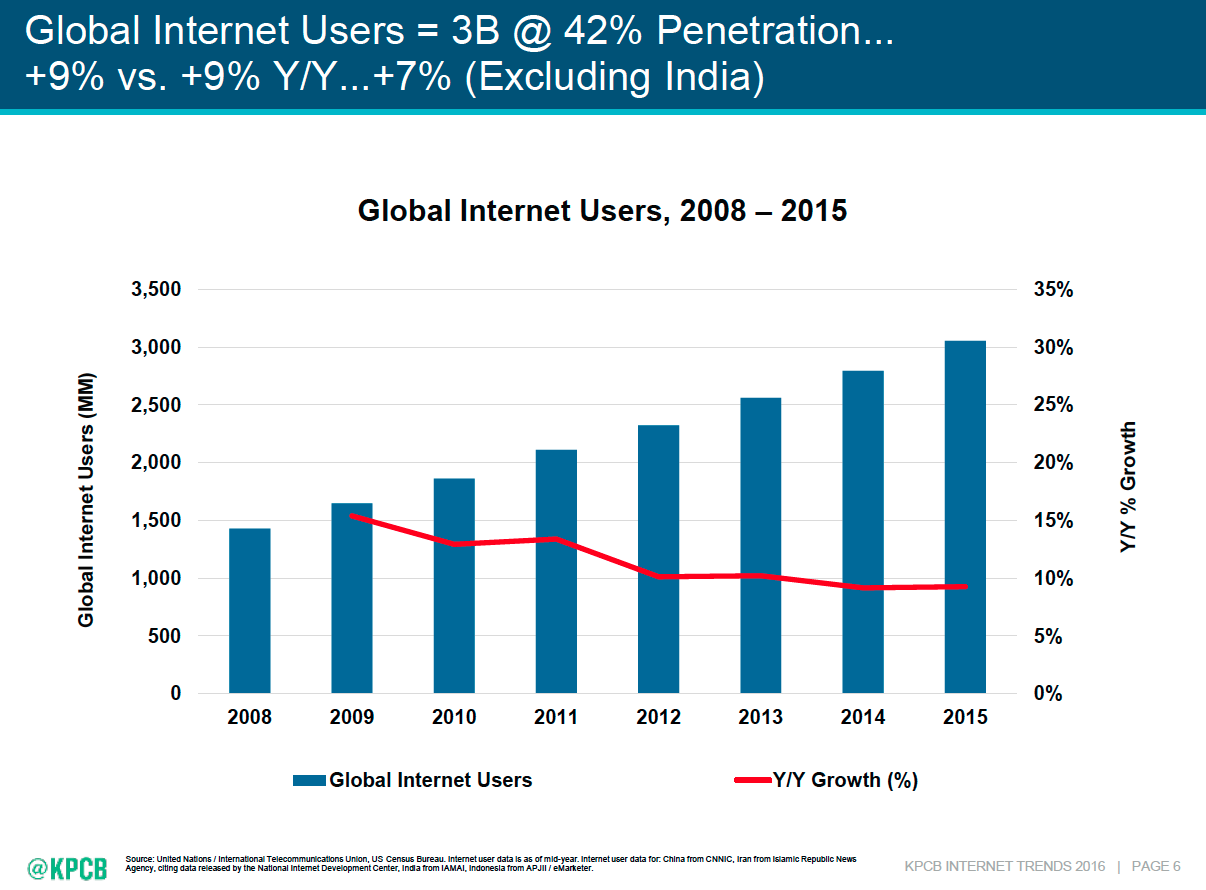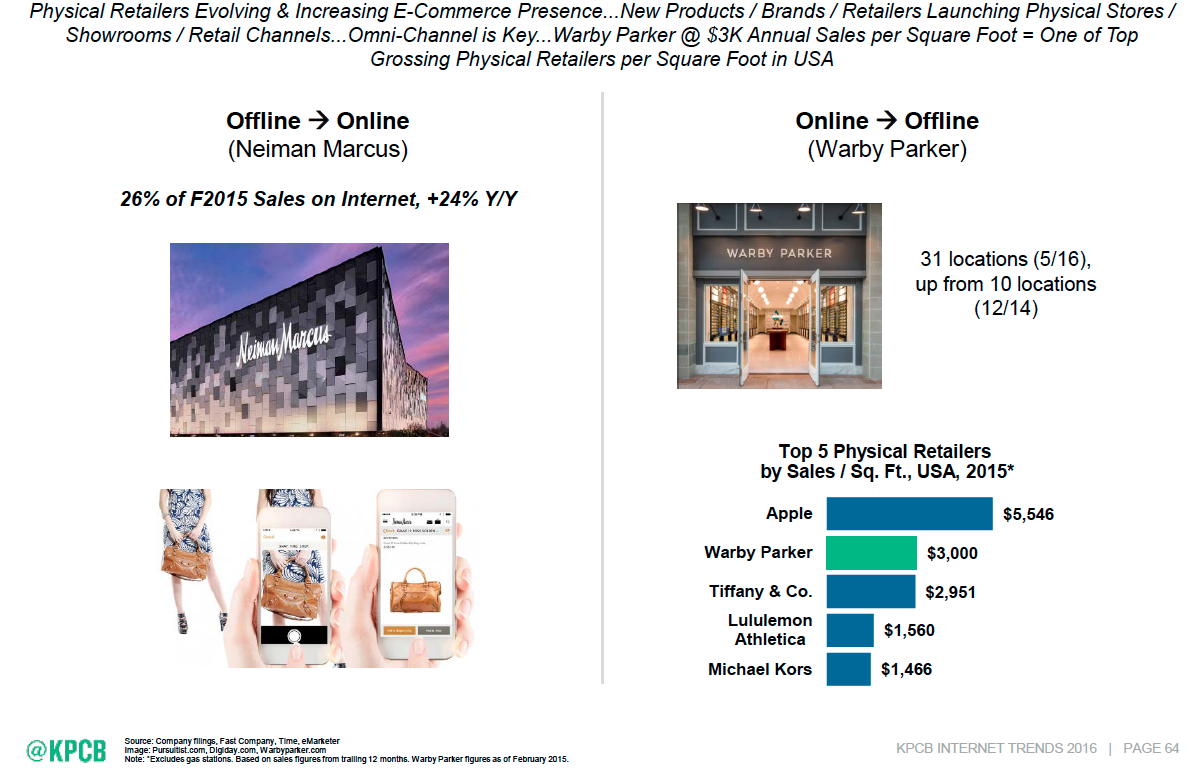
One of the fastest ways to learn what is going on in the tech world is to read Mary Meeker’s annual report. The 2016 Internet Trends Report comes in the form of a 213 slides presentation, covering a wide range of topics from the eternal battle between iOS and Android to the emergence of new markets and customers.
Below you will find the full 2016 report. Here we will focus on five major takeaways, based on eye-opening stats and facts, that will help you better understand what lies beneath the forces of the digital transformation.
The most evident quality of Mary Meeker, a partner at venture capital firm Kleiner, Perkins, Caufield, and Byers, is the ability to provide a complete overview of the threats and opportunities that will guide the evolution of technologies, markets and organizations.
First things first: In 2016 we have reached 3 billion global Internet users. Today, 42% of the world population is online, using desktop computers or - preferably - mobile devices. The smartphone has become the first screen, the primary reference for our daily activities.
It is not all roses, however. The report records a slowing both in connectivity growth (+9% versus +9% year on year) and smartphone adoption (global smartphone shipments from 28% to 10% year on year). The biggest hurdles to the spread of technology right now are the infrastructure issues and the incentives to get online.
If we had to sum up the consequences of all trends described in the Internet report, these would be the most critical for all businesses
- Digital customers have taken center stage, demanding new approaches and personalized contents, mobile first.
- Digital competition has become a worldwide affair, with your fierce competitors likely coming from emerging countries.
- Digital customer experience has replaced products as the most critical business differentiator in digital markets.
Put these trajectories together, and you will find one key rule to overcome the challenges of the digital transformation: To engage and monetize digital customers, and stay top of mind, you must deliver meaningful (contextual, innovative, personalized) customer experiences in every moment of truth.
With adoption rates going flat, the experience becomes even more important to build a distinctive presence through customer engagement. Customers’ decisions are mostly based on the expectation that they can get what they want with ease and speed, wherever they are and whatever device they are using.
When people are connected 24/7, they expect that you can assist and engage them across the entire customer journey, online and offline, on any device.
ANDROID BECOMES THE STANDARD
As said, the smartphone adoption growth is slowing. This is true both for iOS and Android, a sign that the market is saturating, and the emerging countries can’t compensate. Looking at a broader picture, though, there is a huge difference between the two rivals.
Meeker finds, in fact, that over the past six years iOS has seen just a 2% increase in market share, while Android has exploded from a 4% presence in the industry (2009) to 81% (2015). Projections say that this pattern is going to continue in the next years, with Android becoming the standard for digital business projects.

THE INTERNET NEEDS A REVAMP
This is the continuation of what we have seen last year: The Internet growth is facing a steady slowing, and this time this is not due to external factors (macroeconomics trends like the financial crisis) but structural factors. The Internet needs a complete revamp, as it continues to ramp as a retail distribution channel (10% of retail sales).
The Internet of Things, messaging apps (Messenger For Business), social commerce, real-time user-generated broadcasts (Facebook Live) and artificial intelligence assistance (Chatbots) reinvent the Internet to appeal the new breed of digital customers.

MILLENNIALS DICTATE THE RULES
We talk a lot about this new generation of customers called Millennials. While we wait for the Generation Z - those that are now less than 20 years old - to acquire purchase power, Millennials right now are your digital customers. Today, commerce is changing rapidly for this generation, and also brands need to evolve with it.
Millennials make the most powerful force on markets, with a spending power destined to rise significantly in the next 10 or 20 years. Submerged in a mobile ecosystem, they have different core values and expectations. Their behaviors help change marketing and retailing channels, together with the evolution of technology.

RETAIL WILL CHANGE FOREVER
When technology and customer behaviors evolve, the retail industry evolves accordingly. What we face today is the strong, increasing intertwine of technology, media, and distribution, so that physical retailers become digital retailers, and digital retailers become data-optimized physical retailers.
The pervasiveness of the Internet activates the reinvention of the store (at the micro level) and the disruption of the industry (at the macro level). Products and brands are both bolstered by always-on connectivity, hyper-targeted marketing, personalization, and the power of visual.
COMMUNICATION WILL BE RE-IMAGINED
Last but not least, we want to talk exactly about the power of visual. The 2016 report confirms that visual usage continues to rise: Video and images are way more relevant than any other content, when you want to engage digital customers. This trend will be more and more decisive when the Generation Z will be properly shaped.
Already today the online engagement translates into visual engagement (Facebook, Snapchat, Instagram, Facebook Live, Periscope, messaging apps). This leads to an evolution in the way brands communicate and engage digital customers: New channels, new touchpoints, new advertising models.
Most important, we are moving towards a new paradigm in the human-computer interaction. A paradigm that is driven by voice. Typing text into a search bar is becoming old-fashioned. In five years, at least 50% of all searches are going to be either images or speech (Chatbots, anyone?). So we will say goodbye to the Internet as we know it.
Download The Mobile Engagement Playbook, a collection of relevant insights that'll help you to overcome the challenges of the digital transformation and grow your business exponentially.



 Your magnifing glass to deeply understand your users and increase the value of each relatonship.
Your magnifing glass to deeply understand your users and increase the value of each relatonship. Listen to the voice of your customers deeply to understand what they truly want.
Listen to the voice of your customers deeply to understand what they truly want. The Lead Generation Platform to get leads from anonymous traffic on your website.
The Lead Generation Platform to get leads from anonymous traffic on your website.  Understand the behavior of people in physical spaces and monitor safety requirements.
Understand the behavior of people in physical spaces and monitor safety requirements. The Digital Commerce Platform designed to follow the most modern technological standards..
The Digital Commerce Platform designed to follow the most modern technological standards.. The XReality platform to tell brand and product stories by connecting physical and digital worlds.
The XReality platform to tell brand and product stories by connecting physical and digital worlds. Points, rewards, levels, badges, missions: a world of nudges to nurture your customer community.
Points, rewards, levels, badges, missions: a world of nudges to nurture your customer community. Discover all the other solutions!
Discover all the other solutions!









